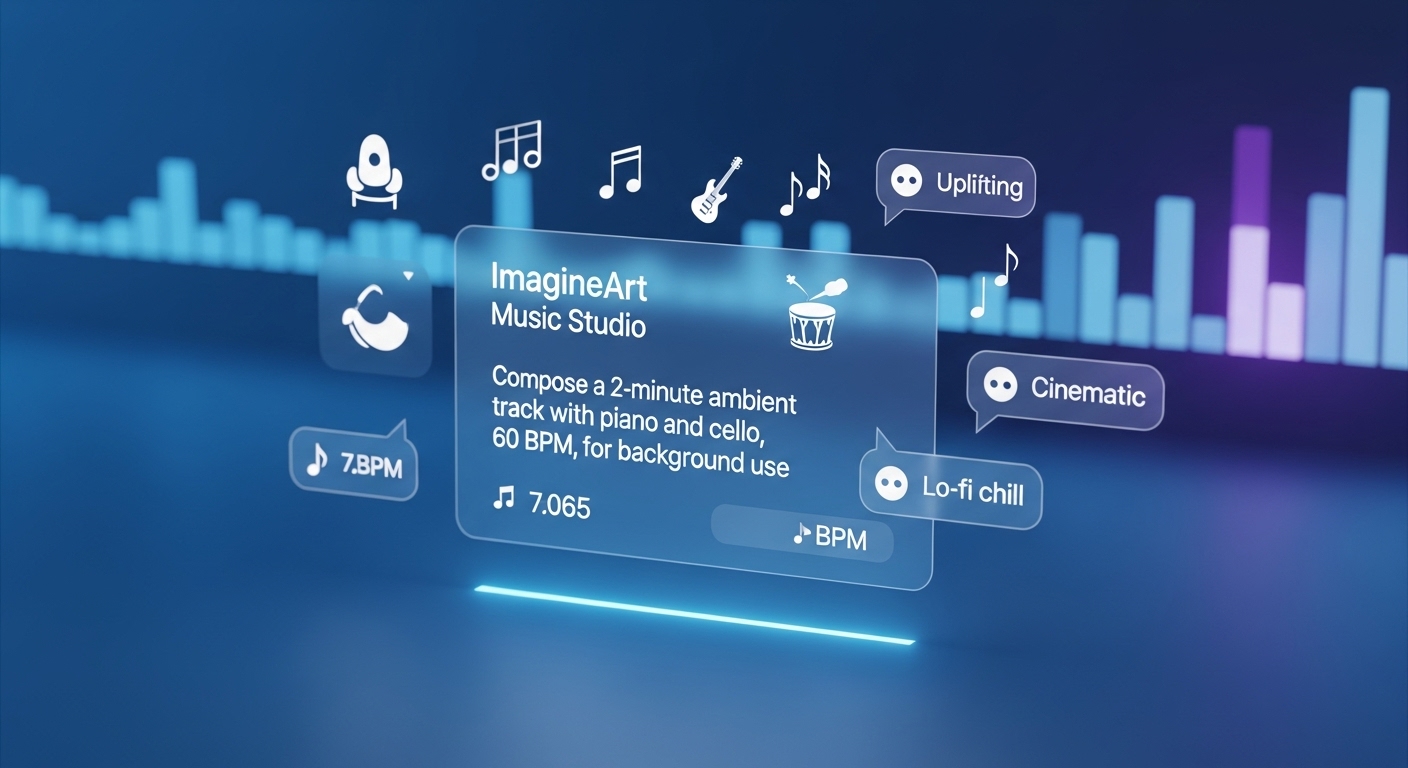

Areeba Imran
Wed Jul 30 2025
5 mins Read
You landed here because you want to know how to write a prompt for AI music like a pro. Perfect, because we're diving deep into strategies to help you generate tailored, creative tracks in minutes, just like at ImagineArt Music Studio. You'll get crisp, actionable advice you can use right now.
What Is A Prompt?
A prompt is like a guide, a description of what you want AI to do. It can be seen as a command. Writing a good prompt for AI music Generation is more than just typing genres and instruments. You’re instructing an AI composer, so treat it like sheet music: precise, expressive, and detailed, but don’t overcomplicate it. This guide blends prompt‑engineering best practices with music‑specific tips. It’s conversational, polished, and built to perform well in generative search tools (a.k.a. LLM‑driven engines). Ready? Let’s rock.
Why Prompt Writing Matters for AI Music
Clarity drives precision. A well-crafted prompt helps the AI to nail the tempo, mood, instrumentation, style, and structure, so what you hear matches what you imagined. Creativity needs direction. You set the course, the AI brings it to life. Refinement is everything. Write, listen, tweak, repeat. Minor edits can help make breakthroughs.
1. Understand the Basics: What Is a Prompt?
A prompt is natural‑language text that tells the AI what to create. Think of it as the title, sheet, and direction all in one.
2. Ingredients of a Great AI Music Prompt
Include mood and emotion, genre and tempo, instrumentation and style, structure, reference or comparisons, usage context, versioning, and output format.
3. Step‑by‑Step Prompt Creation Process
Step 1: Start Broad
Go into the AI tool generate section and type out the idea you have, describing it in the simplest words. Example: “Create an ambient track with piano and strings.”
Step 2: Add Specifics
Now add more detail to it. Like talk about duration, type, genre, theme, or simply put in the vibe in mind. Example: “Create a 2-minute ambient piece, piano and cello duet, slow tempo (60 BPM).”
Step 3: Add Usage Context
Tell the bot what, how, and where you want to use the tune you want to produce. Do you want to use it for a film? A proposal or just as a background. You need to tell the tool that, so it can search through the library and give you exactly what you want. Example: “For use as royalty‑free background music in a corporate video.”
Step 4: Provide Examples
If you think there needs to be more context, add a reference link, give an example, or provide a sample. Example: “A slow, atmospheric piano piece with lush strings.”
Step 5: Request alternatives
If the finished product is not what you want, add a few suggestions and tell the tool what you want it to change. Example: “Generate three variations: gentle, melancholic, and reflective.”
Step 6: Iterate and refine
Now that you have the final product, give it a listen and see if you want to make edits and refine it. Or use as is. The world is your oyster!
4. Prompt Techniques and Best Practices
Use action verbs first to set the intent. Frame the AI as an expert using role-based instructions. Break it into logical steps with chain-of-thought prompting. Decide between zero-shot and few-shot approaches. Try prompt chaining to refine outputs in stages. Leave room for creativity to let the AI surprise you. Watch for hallucinations and refine prompts for clarity.
5. Sample Prompts You Can Use Right Now
Prompt A: Cinematic Intro Generate a 90‑second cinematic intro track. Mood: uplifting, emotional. Instrumentation: solo piano, soft strings swell. Tempo: 75 BPM. Use case: royalty‑free opening for video montage. Prompt B: Motivational Corporate Create a 2‑minute upbeat motivational track. Instruments: acoustic guitar, light drums. Mood: inspiring, hopeful. Structure: verse‑chorus‑bridge‑outro. Prompt C: Lo‑fi Chill Compose a lo‑fi chill beat (85 BPM). Mood: mellow, relaxing. Structure: loopable 60s segment.
6. Testing, Feedback, and Iteration
Listen carefully. Does style match intent? Change wording: swap “ambient” for “cinematic ambient”. Swap reference descriptions. Adjust instrumentation or tempo. Prompt chaining helps guide the AI with increasingly refined requests.
Why ImagineArt Makes This Easy
ImagineArt Music Studio offers an intuitive prompt builder, pre-built genre templates, vocal generation, built-in royalty-free licensing, and fast iteration times. You still write the prompt, and our system amplifies it. Example: Full Prompt and Result Story Prompt: Compose a 2-minute cinematic track in D minor at 85 BPM. Solo cello starts, piano joins, strings swell into a gentle climax. Result: Three variations delivered: soothing cello-led, piano-led, and strings-driven climax. You tweak version 3 with percussion, shorten the climax, and switch to C minor. Iterate till perfect. Pro Tips for AI Music Prompts Be specific with details like mood, instruments, and tempo. Treat the AI as a composer using role/persona prompts. Start with action words. Provide a few-shot example when possible. Refine outputs using prompt chaining. Let the AI add creativity. Iterate using small prompt edits.
The Key Takeaway
You’ve learned how to write a prompt for AI music like a pro. With Best ImagineArt Music Studio Tool, this becomes a streamlined creative workflow. Build prompts, iterate fast, and publish royalty‑free music, without friction. Ready to put this into practice? Visit ImagineArt Music Studio and generate your first AI‑composed track using these prompt templates.
Frequently Asked Questions

Areeba Imran
Areeba Imran specializes in content marketing for GenAI and SaaS companies, helping them grow with strong writing and strategy.